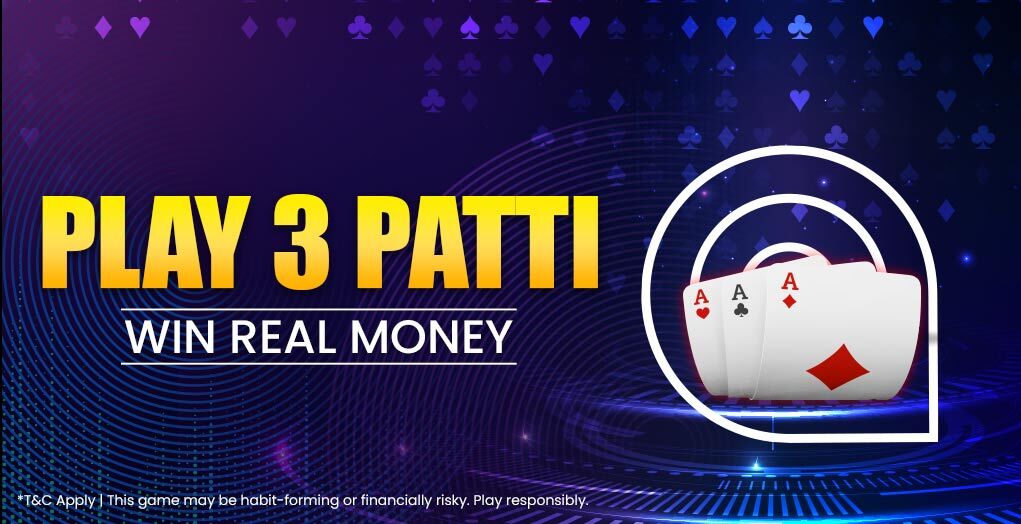Teen Patti
Introduction,
Teen Patti is a well-known card game played in many Indian households. It has gained immense popularity globally and has a monthly active player base of over 6 million. 3 Patti, also known as Teen Patti, Indian Poker, Three-card Poker, or Flush, is a card game that is played with a standard deck of 52 cards. Winning this game requires a combination of both strategic thinking and skills.
What is Teen Patti Real Cash Game?
Online gaming platforms allow you to play the teen Patti real cash game for real money. Here players pay a fee to join, and if they win, they receive the winning amount. Along with 3 Patti, various online platforms offer games like rummy, poker, and gin for players to play with real money. In teen patti real cash game, players engage in the online version of the traditional game, playing against other online participants. However, the goal and rules are similar to the offline version. The winner of these games can instantly withdraw the real cash they've earned.
Common Terms in Teen Patti Games
Boot:
The boot is the entry fee, also known as the ante. Players have to contribute a minimum amount of money to the pot at the start of the game. Its purpose is to create a starting pot for the game.
Post:
The post is the entry fee for the players who want to join the game after the boot. It is the mandatory contribution that players have to make in the pot before the hand is dealt.
Stake Amount:
The stake amount is the total amount of money that is bet in the game. It includes the boot and the posts made by the players.
Call & Raise (Chaal):
Call and raise are two actions that a player can take during the game. Players match the current bet to stay in the game when they call. When players raise, they increase the current bet, forcing other players to match their new bet or fold.
Show (Showdown):
The show (or showdown) is the game's final stage, where players reveal their cards, and the winner is determined. To reach the showdown, at least two players must remain in the game after the final round of betting.
Blind Player:
A blind player bets without checking their cards. They have the option to play blind, fold, and show.
Seen Player:
The seen players bet after checking their cards. They have the option to either call or raise the current bet.
Fixed Limit:
In this variation, the amount that can be bet or raised during each betting round is limited to a predetermined amount.
Spread Limit:
Here, the range of permissible bets is specified, allowing players to bet within that range.
Pot Limit:
Players can bet or raise the total amount in the pot at any time in this variant.
No Limit:
This is the most popular form of Teen Patti, where players can bet or raise any amount they desire, including going all-in (betting all of their chips).
How to Play Teen Patti Online Game– 3 Patti Game Rules
Teen Patti Rules
It is essential to learn the Teen Patti rules to experience the game better and excel in it:
- Typically played among 3 to 6 players using a standard deck of 52 cards (without Jokers)
- The objective is to create the highest-ranking 3-card hand according to the hand-ranking rules
- Ace cards hold the highest value, while 2s hold the lowest
- Each participant contributes a boot amount to the pot to begin the game
- At the start of each hand, the participants are dealt three face-down cards
- The betting commences with the player sitting immediately left to the dealer
- The initial stake for the first betting player is equal to the boot amount
- Depending on the strength of their hand, a player can choose to either bet or fold their cards
How to Play?
Here’s how to play teen patti games online:
- Download a trusted 3Patti online game app and sign up for it
- Deposit real money to your app wallet through the available payment methods
- Choose a 3 Patti table of your preference
- Use your skills and strategies to play TeenPatti games and win real cash
Teen Patti Hands Rankings
The hand ranking in Teen Patti determines the hierarchy of hands from the highest-ranking to the lowest-ranking. It is crucial to understand these rankings to assess the strength of your hand and make strategic decisions during the game. Here is a detailed explanation of teen patti sequence:
Three-of-a-Kind: A hand with three cards of the same rank is Three-of-a-Kind. It is the highest-ranking hand and can beat all other hands. Three Aces is the highest Three-of-a-Kind hand.
Pure Sequence: This hand consists of sequentially three cards of the same suit. A-K-Q of the same suit is the highest-ranking Pure Sequence.
Sequence: This hand consists of three cards in a sequential order. A-K-Q of any suit is the highest-ranking Sequence.
Flush: A hand with three cards of the same suit is a Flush. Ace-high is the highest-ranking Flush hand, beats King-high, Queen-high, and so forth.
Pair: Two cards of the same rank are a Pair. Two Aces are the highest-ranking Pair, followed by Kings Pair, Queens Pair, and so forth.
High Card: A High Card is the highest-ranking card in your hand. The card with the highest rank is your High Card.
Online Teen Patti Game Hands Probability:
The probability of winning with a particular hand depends on the number of combinations of cards that can form that hand and the probability of getting those cards from the deck. The following are the probabilities of getting different hands in 3 patti real cash game:
| Hand Name | Frequency | Probability | Odds in Favour |
| Three-of-a-Kind | 52 | 0.24% | 424.00:1 |
| Pure Sequence | 48 | 0.22% | 459.42:1 |
| Sequence | 720 | 3.26% | 29.69:1 |
| Flush | 1096 | 4.96% | 19.16:1 |
| Pair | 3744 | 16.94% | 4.90:1 |
| High Card | 16440 | 74.39% | 0.34:1 |
Teen Patti Game Variations
Teen Patti has various exciting variations that add twists to the gameplay. Best of Four, Muflis, Stud, AK47 - there’s a variation for every type of player. So, whether you’re a pro or a novice to the 3 Patti world, the game will keep you entertained and engaged. Here are the most popular 3 Patti game variations:
- Best of Four
- Lowball (Muflis)
- Wild Draw
- Low Wild
- High Wild
- Two-Lowest Wild
- Bust Card Draw
- Stud
- Community
- 999
- AK47
- Classic 3 Patti
- Draw
- High Low Split
- Kiss, Miss, and Bliss
- Cobra
- Blind (Kana) King and Jack
Teen Patti Tash Game- Playing Styles
Loose Play:
Loose players are more willing to take risks and may enter pots with weaker hands. They rely on unpredictability and may catch opponents off guard.
Tight Play:
Tight players wait for premium hands and play only when they have a strong chance of winning. They are disciplined and patient, avoiding unnecessary risks.
Aggressive Play:
Aggressive players aim to intimidate and force opponents to fold or make mistakes. They often rely on bluffing to win pots.
Conservative Play:
Conservative players focus on minimising losses and staying in the game for the long haul. They may wait for strong hands before committing significant chips.
Bluffing Play:
Bluffers attempt to make others fold by creating a false impression of having a powerful hand. Success depends on the ability to read opponents and choose the right moments to bluff.
Calculative Play:
Calculative playing style uses a mathematical approach to maximise chances of winning. Calculative players consider the pot odds, implied odds, and other factors in decision-making.
Passive Play:
A passive playing style involves letting others take the lead and reacting to opponents' actions. Passive players may avoid confrontation and focus on staying in the game rather than aggressively pursuing pots.
Online 3 Patti Real Money Moves
Players have various moves they can make during the game:
Blind Play:
Players can play blind, meaning they don't look at their cards and continue in the game based on intuition or reading other players' actions.
Play Chaal Phase:
After the initial betting rounds, players can continue playing by making a "Chaal" bet, which matches the previous bet.
Sideshow:
In some variations, players have the option to compare their cards with another player and, based on the outcome, either continue playing or fold.
Show:
When all the betting rounds are complete, the remaining players reveal their cards, and the player with the best hand wins the pot.
Teen Patti Game Strategies
- Start with small bets and gradually increase to extend your bankroll, allowing for more hands and increased winning chances
- In 3Patti, there are no inherently bad cards. Guessing opponents' cards is crucial, as players may fold even with better hands, providing opportunities to win with seemingly inferior cards
- Being predictable reduces your chances. Stay enigmatic and be ready to surprise opponents by avoiding set patterns in your gameplay
- Stay observant to gain insights into opponents' playing styles even after folding. This awareness can offer a significant advantage in future hands
- Some players forfeit weak hands too soon, losing out on potential advantages. Stay engaged and observant even after giving up your cards to understand your opponents better
Teen Patti Game vs Poker Game
Similarities:
- Both Teen Patti game and Poker game typically commence with a forced bet, often referred to as 'the blind’
- The betting sequence in both games begins with the player next to the dealer and proceeds in a clockwise direction around the table
- The dealer plays a crucial role in both games, handling cards for each hand and dealing them one at a time in a clockwise manner
- Variants exist in both Teen Patti and Poker, yet they share similar gameplay patterns and use the same hand rankings
Differences:
- 3 Patti gives 3 cards per player, while Poker deals 5 cards to each player
- 3Patti involves blind betting without knowing opponents' cards, whereas Poker players bet based on hand strength and the opponent’s actions
- Teen Patti requires strategy with limited information (own cards only), while Poker players have more info with their own cards and community cards
Frequently Asked Questions
What is Teen Patti?
Teen Patti, also known as Indian Poker, is a popular card game from India. It is a simplified version of poker played with a standard deck of 52 cards and involves strategic betting and bluffing.
What is the highest hand sequence in the Teen Patti skill game?
The best hand in Teen Patti is a Trail, having three cards of the same rank. The ranking order, from highest to lowest, is A-K-Q, A-2-3, K-Q-J, Q-J-10, and so on, down to 4-3-2.
How to play 3 Patti online?
To play 3 Patti online, pick a trustworthy gaming website. Sign up, select your game type, and set your betting limits. Follow the game rules, apply your skills, and use strategies to win.
Is Teen Patti a game of skill?
Teen Patti is considered a game of skill because it involves a lot of probability and mathematics. A skilled player can calculate the chances of getting a good hand by analysing the dealt cards and betting patterns.
Conclusion:
In summary, Teen Patti is a skill game requiring strategic thinking. Its simplicity makes it a popular game with a significant impact on Indian culture. This card game is more hands-on than other casino games that require training and hard work. This makes 3 Patti more enjoyable and is often chosen for family game nights. As for online 3Patti, it comes with its own set of challenges and rewards.

